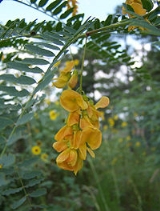
Sesbania
Overview
Flowering plant
The flowering plants , also known as Angiospermae or Magnoliophyta, are the most diverse group of land plants. Angiosperms are seed-producing plants like the gymnosperms and can be distinguished from the gymnosperms by a series of synapomorphies...
s in the pea
Pea
A pea is most commonly the small spherical seed or the seed-pod of the pod fruit Pisum sativum. Each pod contains several peas. Peapods are botanically a fruit, since they contain seeds developed from the ovary of a flower. However, peas are considered to be a vegetable in cooking...
family, Fabaceae
Fabaceae
The Fabaceae or Leguminosae, commonly known as the legume, pea, or bean family, is a large and economically important family of flowering plants. The group is the third largest land plant family, behind only the Orchidaceae and Asteraceae, with 730 genera and over 19,400 species...
and the only genus found in Tribe Sesbanieae. Notable species include the Rattlebox (Sesbania drummondii
Sesbania drummondii
Sesbania drummondii, known as Rattlebush, Rattlebox and Poison bean, is a medium-sized perennial shrub in the legume family Fabaceae. It is native to the southeastern United States, from Texas east to Florida....
), Spiny Sesbania (Sesbania bispinosa
Sesbania bispinosa
The legume Sesbania bispinosa, also known as Sesbania aculeata Pers., is a small tree in the genus Sesbania.The flower is the provincial flower of Phra Nakhon Si Ayutthaya Province, Thailand.-Names:...
), and Sesbania sesban
Sesbania sesban
Sesbania sesbanSynonyms for the species name include:*Aeschynomene aegyptiaca Steud.*Aeschynomene elongata Salisb.*Aeschynomene sesban L.*Dolichos aeschynome-sesban Forssk.*Emerus*Sesbania punctata DC....
, which is used in cooking. Plants of this genus, some of which are aquatic
Aquatic plant
Aquatic plants are plants that have adapted to living in aquatic environments. They are also referred to as hydrophytes or aquatic macrophytes. These plants require special adaptations for living submerged in water, or at the water's surface. Aquatic plants can only grow in water or in soil that is...
, can be used in alley cropping to increase
Nitrogen fixation
Nitrogen fixation is the natural process, either biological or abiotic, by which nitrogen in the atmosphere is converted into ammonia . This process is essential for life because fixed nitrogen is required to biosynthesize the basic building blocks of life, e.g., nucleotides for DNA and RNA and...
the soil
Soil
Soil is a natural body consisting of layers of mineral constituents of variable thicknesses, which differ from the parent materials in their morphological, physical, chemical, and mineralogical characteristics...
's nitrogen
Nitrogen
Nitrogen is a chemical element that has the symbol N, atomic number of 7 and atomic mass 14.00674 u. Elemental nitrogen is a colorless, odorless, tasteless, and mostly inert diatomic gas at standard conditions, constituting 78.08% by volume of Earth's atmosphere...
content. The species of Rhizobia responsible for Nitrogen fixation in Sesbania rostrata is Azorhizobium caulinodans
Azorhizobium caulinodans
Azorhizobium caulinodans is a species of bacteria, which forms a nitrogen-fixing symbiosis with plants of the genus Sesbania....
.

